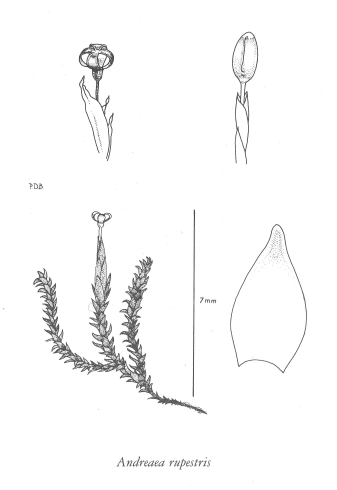Andreaea rupestris Hedw.
black rock-moss (andreaea moss)
Andreaeaceae
Species Account Author: Wilf Schofield
Extracted from Some Common Mosses of BC
Introduction to the Bryophytes of BC
black rock-moss (andreaea moss)
Andreaeaceae
Species Account Author: Wilf Schofield
Extracted from Some Common Mosses of BC
Introduction to the Bryophytes of BC
SUBTAXA PRESENT IN BC
Andreaea rupestris var. rupestris
Species Information
Species description:
Genus named to honour G.R. Andreae a German apothecary in the 18th century; the species derived from the habitat: rock.
Reproduction:
Sporophytes black or dark red-brown, relatively frequent, maturing in spring or, at high elevations, after snow melt.
Distinguishing characteristics:
Any dark brown to black moss that forms tufts of tiny plants on plane rock surfaces (rather than in crevices) is likely to be Andreaea. With opened sporangia, when dry, the genus is very characteristic since the four or more longitudinal openings gape to release spores.
Habit:
Forming black to dark red-brown tufts or cushions.
Similar Species:
There are ten species of Andreaea in the province; four resemble A. rupestris and are not readily distinguishable without microscopic examination and experience. The other five, A. blyttii, A. nivalis, A. megistospora, A. rothii, and A. schofieldiana have a distinct midrib. The largest is A. nivalis in which the leaves are usually strongly curved and reddish to brown, the plants are usually more than 50 mm long and soft, while A. rupestris rarely has stems as long as 10 mm and stems are brittle. A. nivalis is usually at higher elevations and most frequent in late snow areas. A. blyttii forms short black turfs over rocks in late snow areas.
Illustration

If more than one illustration is available for a species (e.g., separate illustrations were provided for two subspecies) then links to the separate images will be provided below. Note that individual subspecies or varietal illustrations are not always available.
Illustration Source: Some Common Mosses of BC
Habitat and Range
Habitat
Exposed to somewhat shaded siliceous rock surfaces (cliffs, boulders of talus) from sea level to subalpine and alpine elevations. Range
World DistributionWidespread in cooler climates of the Northern Hemisphere; reported also as scattered in cooler parts of the Southern Hemisphere; in North America, extending across the boreal region and southward along mountain chains of both east and west coasts.
